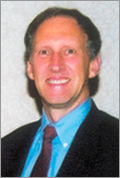200th ECS Meeting | San Francisco, CA | Sept. 3, 2001
Field-Induced Charges in Organic Crystals: New Perspectives for Science and Technology
The plenary lecture, entitled, “Field-Induced Charges in Organic Crystals: New Perspectives for Science and Technology,” was given by Bertram Batlogg, a Professor of Physics at ETH, Zurich. The talk focused on a new generation of organic semiconductors, their attributes relative to inorganic semiconductors such as Si and Group II-V compounds, and their applicability to molecular electronics and opto-electronic devices. These materials cover a wide spectrum and include buckyballs, oligothiophenes, and organic compounds with extended pi-electron conjugation such as pentacene and tetracene. Dr. Batlogg reminded the audience of a key structural feature of these materials, namely, an absence of surface states that results from the van der Waals bonding of their constituent molecules. Surface states, of course, are a bane for a given semiconductor in terms of its electronic properties and device applicability.
The speaker pointed out that organic semiconductors (or molecular crystals) are usually grown by vapor phase transport. Doping is accomplished by using iodine as a carrier. Dr. Batlogg discussed alternative doping strategies based on field-effect doping. Contrasting with conventional approaches, field-effect doping allows for two-dimensional tuning of the carrier density over a 109-1014 cm-2 range, simply by varying the applied voltage to a field-effect transistor (FET) configuration. Hole mobilities as high as 105 cm2 V/s have been attained in organic semiconductors with carrier scattering losses lower than most inorganic counterparts except GaAs grown by molecular beam epitaxy. Using pentacene as a model system, he described ambipolar FET devices made from either n-type or p-type channels generated by the field-effect doping method. In terms of switch speed, frequencies up to ca. 700 kHz have been attained. A five-stage ring oscillator was shown as an example, with pentacene as the active component. This device had a delay of 0.15 microsec/stage and a channel width of 25 micrometers.
In terms of optoelectronic device applications, Dr. Batlogg pointed out that the grain boundaries in pentacene have a co-operative effect such that they have only a minimal impact on carrier mobility. Photovoltaic devices, again based on pentacene as the semiconductor and ZnO and Au as collector contacts, exhibit a light-to-electricity conversion efficiency in the 2.7-4.5 % range. Other device examples discussed included a light-emitting transistor based on tetracene for laser applications.
These materials also appear to show promise in the search for high Tc superconductors. Thus pentacene and tetracene have insulator-to-superconductor transitions of 2 K and 2.5 K respectively. Solution-processed polythiophenes constitute another category of promising organic materials in this regard. The fast-moving talk concluded with a discussion on C60and gate-induced hole superconductivity in it. Professor Batlogg pointed out that field-effect doping, while not a new approach in and of itself, opens a new way to the simultaneous study of materials, many-body physics problems, and devices. He similarly underlined the fact that organic semiconductors may not replace Si-based electronics in the near future. Rather, they provide an intriguing and low-cost alternative for throw-away electronic devices. All in all, this talk had the right balance of depth and the broad-brush perspective befitting a plenary lecture. A packed audience of specialists and neophytes alike in the overlapping field of molecular electronics and materials science certainly enjoyed it.

